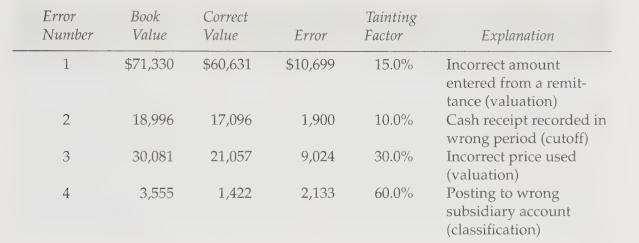You are conducting dollar unit sampling (DUS) of the accounts receivable balances of an agricultural co-op. You
Question:
You are conducting dollar unit sampling (DUS) of the accounts receivable balances of an agricultural co-op. You are willing to accept a 5 percent risk of incorrect acceptance, the book value of the account is \(\$ 2,500,000\) and your sample size (based on a tolerable error limit of \(\$ 125,000\), an expected tainting factor of 100 percent and an expected deviation rate of zero) is 59 . The results of your sample are as follows:

a. Using the results of your sample and an assumed tainting factor of 100 percent, calculate the upper error limit (UEL). Interpret the result.
b. Repeat Part a but with actual tainting factors. Interpret the difference between that result and the result from Part a.
c. Calculate the UEL (using actual tainting factors) assuming a 10 percent acceptable risk of incorrect acceptance as opposed to a 5 percent level. Why is the result different from your result in Part b?
Step by Step Answer:

Auditing Assurance And Risk
ISBN: 9780324313185
3rd Edition
Authors: W. Robert Knechel, Steve Salterio, Brian Ballou





